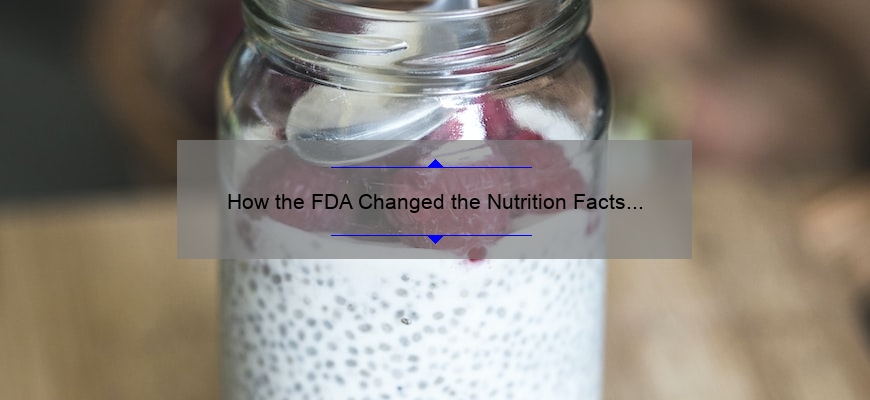The Food and Drug Administration (FDA) is making minor changes to the labels on the Nutrition Facts and Supplement Facts. Most food manufacturers must start using the new brand by July 26, 2018. Those manufacturers with less than $10 million in annual food sales will have an extra year to comply with the new rules. The FDA is planning outreach and education efforts to help manufacturers adjust to the new label requirements.
Serving sizes reflect what people currently eat.
Serving sizes on food labels are based on what people typically eat and drink. According to the FDA, serving size must be found on the amount people usually eat during one eating or drinking occasion. Since people’s eating habits have changed over the past two decades, serving sizes have also changed.
The FDA has proposed changing the serving size for 17 percent of packaged foods. It is also proposing to add serving-size labels to many foods. For example, 20-ounce bottles would count as one serving, while the serving size for an ice cream carton would be raised to one cup.
The FDA recently updated the serving size of yogurt. The new reference amount for yogurt is six ounces. The FDA uses this size because individual yogurt packages are often sold in six-ounce containers. For ice cream, the serving size is now two-thirds of a cup.
The size of a serving depends on many factors, including social situation, advertising, and labeling. In addition to the type of food, attitudes, knowledge, and motivation may also influence portion size. In addition, the amount of packaging a serving contains affects the size of a portion.
Updated criteria for “healthy” claim
A new proposal from the Food and Drug Administration (FDA) would update food labels’ “healthy” claim. The proposed change would align the “healthy” claim with current nutrition science. The revised criteria would focus on the various nutrients a food contains and their synergistic effects.
Foods that qualify for the “healthy” claim will not contain too much-saturated fat, sodium, or added sugars. These factors can raise the number of calories consumed and increase the risk of chronic diseases. Therefore, they can diminish the benefits of the “healthy” claim.
Updated criteria for “healthy” claim: According to current research, some foods cannot carry a “healthy” claim. For example, salmon does not qualify because of its high-fat content. In addition, the current definition of “healthy” food is not based on the latest dietary guidelines or scientific evidence.
In addition to the definition of “healthy,” the proposed regulation also outlines the requirements for the “healthy” implied nutrient content claim on food labels. The “healthy” claim means that the food is rich in particular nutrients that can help the body maintain healthy dietary habits. However, this claim is inconsistent with the purpose of nutrient content claims on food labels.
For example, dairy products with 10 percent or less of DV of saturated fat will qualify for a “healthy” claim if the other criteria are met. This includes products containing 10 percent or less of DV of saturated or trans fat. The new standards are intended to provide clarity and consistency in the label.
Updated criteria for “nutrient content claim.”
The newly proposed criteria for “nutrient content claim” on the nutrition facts label expand the category of foods that qualify as “healthy.” The new standards emphasize the overall nutrient content of food rather than focusing on a single nutrient. These updated criteria also better reflect the synergistic effects of different nutrients.
The updated criteria will be based on the current science of nutrition. They will include changes to the DVs for some nutrients and a declaration of added sugars. These changes will help to protect the health of American consumers better. The new criteria will be effective on foods and beverages that carry the nutrient content claim.
The new criteria are based on current research and Federal dietary guidance. Generally, foods that are low in saturated fat and high in unsaturated fats are healthier. However, oils like canola and olive do not meet the nutrient content required for the claim. These oils do not contain adequate calcium, protein, dietary fiber, or iron levels. Therefore, the existing “nutrient content claim” is inconsistent with the long-standing purpose of nutrient content claims.
The updated criteria for the “nutrient content claim” on nutrition facts labels emphasize the need to consider the whole dietary pattern to make appropriate choices for the consumer. The claim must be accurate and conform to the latest nutrition science and Federal nutritional guidance. For example, canned fruit products must contain specific amounts per serving, even though they may contain additional ingredients that impact the piece of fruit. Furthermore, fruits and vegetables that have been processed must meet the nutrient-to-limit criteria.
The updated criteria for “nutrient content claim” on the nutrition facts label include the percentage of DV for each nutrient. Using these percentages, the requirements for “nutrient content” claims will be more flexible and lasting. DVs are reference amounts of nutrients that should be consumed daily. In the past, they were based on the nutritional requirements of children four and older, but recent revisions of the Nutrition Facts label established a nutrient-specific RDI for infants up to 12 months.
Additionally, oils no longer count as a food group equivalent in combination foods. The FDA has rejected a consensus definition of complex carbohydrates, but they have dietary benefits. These are allowed voluntarily as “other carbohydrates” and are calculated as the carbohydrate left after subtracting sugars and dietary fiber.


